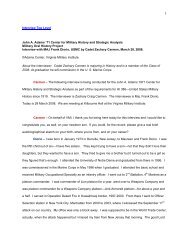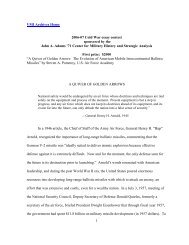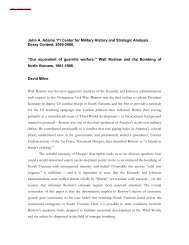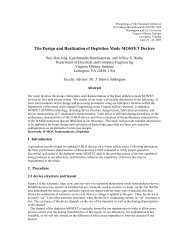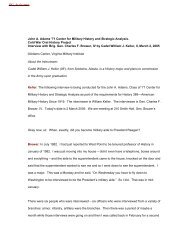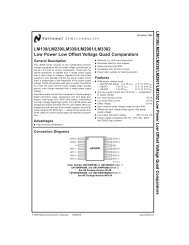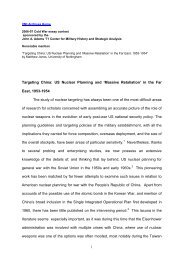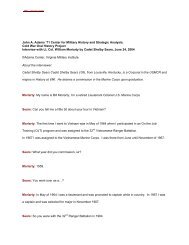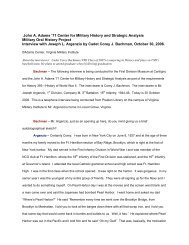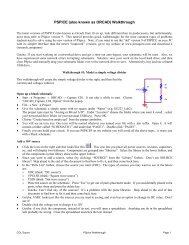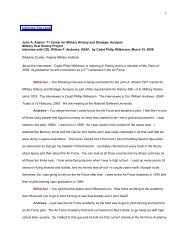Academic Catalog - Virginia Military Institute Admissions
Academic Catalog - Virginia Military Institute Admissions
Academic Catalog - Virginia Military Institute Admissions
Create successful ePaper yourself
Turn your PDF publications into a flip-book with our unique Google optimized e-Paper software.
<strong>Virginia</strong> <strong>Military</strong> <strong>Institute</strong><br />
CIVIL AND ENVIRONMENTAL ENGINEERING<br />
DEPARTMENT OF CIVIL AND ENVIRONMENTAL ENGINEERING<br />
DEPARTMENT Head: CAPTAIN RIESTER<br />
Requirements for a major in civil engineering are specified on pages 44-47.<br />
CE 104. CE DRAWING 2—0—2<br />
Engineering mechanical drawing and computer-aided drafting with applications to CE.<br />
Topics include mechanical drawing and computer-aided technical sketching and shape<br />
description, orthographics, isometrics, and dimensioning. Practical applications engineering<br />
CAD projects reinforce learning.<br />
CE 105. INTRODUCTION TO CIVIL ENGINEERING 0—2—1<br />
An introduction to the civil engineering profession providing an overview of its history,<br />
specialty areas, responsibilities, and importance to the civilian infrastructure. Engineering<br />
computations, presentation of results, and elementary design projects are covered.<br />
CE 121. SURVEYING 2—3—3<br />
Surveying instruments, measurements of horizontal and vertical distances and direction,<br />
traverse computations, topographic mapping, and construction surveys.<br />
CE 123. ENGINEERING CALCULATION TOOLS 2—0—2<br />
The use of spreadsheets and MathCAD for calculus and civil engineering computations<br />
including root finding, solutions to systems of linear equations, optimization, statistics,<br />
numerical integration and differentiation, and error analysis. Corequisite: MA 123.<br />
CE 206. SOLID MECHANICS 3—0—3<br />
A study of the behavior of non-rigid bodies when subjected to external tension, compression,<br />
bending, torsional loads or a combination of these loads. Development of mathematical<br />
expressions that relate to external loads, member properties, and internal stresses, strains,<br />
and deflections. Includes elastic and plastic stress theory. Prerequisites: MA 124 and C or<br />
better in ME 201.<br />
CE 208X. INTRODUCTION TO GEOGRAPHIC INFORMATION SYSTEMS (GIS) 3—0—3<br />
An introduction to Geographic Information Systems (GIS) including Global Positioning<br />
Systems (GPS) as pertinent to past and current practices along with future trends of the<br />
21st Century. The usage of both GIS/GPS is growing exponentially and is applicable to all<br />
majors in civilian and military applications. Case histories and software exercises are used<br />
to introduce GIS/GPS and the global concepts therein. A variety of information types along<br />
with digital maps will be utilized to study historic aspects of American culture in conjunction<br />
with basic cultural patterns in other regions of the world. Digital GIS maps allow regional<br />
or global trends to be visualized, compared, measured, queried, and analyzed. CE 208X is<br />
offered as a Civilizations and Cultures (C&C) Course and is open to all majors. Civilizations<br />
and Cultures (X).<br />
CE 214. CIVIL ENGINEERING METHODS WITH PROBABILITY AND STATISTICS 3—0—3<br />
Numerical methods applied to matrix manipulations and elimination techniques, and to<br />
linear programming. Review of probability and statistics to include discrete and continuous<br />
random variables, probability and cumulative density functions, central tendency, variability,<br />
skew, probability rules, and permutations and combinations. Application of probability<br />
distribution functions and confidence intervals and hypothesis testing, curve fitting including<br />
general linear least squares regression and linear regression, goodness of fits; and linear<br />
transforms, and interpolation to civil engineering practice. Computer spreadsheet applications.<br />
Prerequisite: CE 123.<br />
CE 301. STRUCTURAL THEORY 3—0—3<br />
Analysis of statically determinate and indeterminate structures. Application of computers<br />
to structural analysis. Prerequisites: C or better in CE 206.<br />
CE 302. CIVIL ENGINEERING DYNAMICS 3—0—3<br />
Vector and scalar methods in kinematics, including absolute and relative motion of particles<br />
and rigid bodies; kinetics, with solutions of rigid bodies by the methods of force, mass and<br />
acceleration, work and energy, and impulse and momentum. Analysis of single degree of<br />
freedom systems. Prerequisite: ME 201.<br />
CE 307. PROPERTIES OF ENGINEERING MATERIALS 2—3—3<br />
A study of mechanical properties of engineering materials with special emphasis on<br />
Portland cement concrete. Materials studied include wood, metals (steel and nonferrous<br />
metals), plastics, glass, clay, bituminous materials and Portland cement concrete. Materials<br />
testing, specifications, and design are examined through both classroom and laboratory<br />
work. Prerequisite: CE 206.<br />
CE 309. FLUID MECHANICS 3—0—3<br />
Elementary mechanics of fluids. Fluid properties; hydrostatics; fluid kinematics; equations of<br />
motion; energy equation; momentum principles; flow of liquids and gases in closed conduits;<br />
principles of dimensional analysis and dynamic similitude. Prerequisites: ME 124 and ME 201.<br />
CE 310. SOIL MECHANICS 3—3—4<br />
Origin, nature, and classification of soils; analysis and laboratory tests to determine the<br />
engineering and index properties of soils and their application to various design considerations.<br />
Prerequisite: C or better in CE 206.<br />
12-13 <strong>Catalog</strong>ue<br />
CE 319. WATER resources laboratory 0—3—1<br />
Laboratory experiments and statistical analysis of hydrological and hydraulic processes;<br />
analysis and design of water distribution systems. Prerequisites: CE 309 and CE 321.<br />
Writing Intensive (W)<br />
CE 321 ENVIRONMENTAL ENGINEERING 2—3—3<br />
Environmental engineering aspects of pollution control including a review of environmental<br />
chemistry; water/wastewater and industrial waste characteristics; air quality; pertinent<br />
environmental regulations; reactor engineering and wastewater treatment; municipal and<br />
industrial wastewater treatment plant design; design of air pollution control technologies;<br />
and a review of risk assessment.<br />
CE 322. WATER RESOURCES ENGINEERING 3—0—3<br />
Analysis of hydraulic problems associated with the design of civil engineering structures,<br />
analysis and design of public water supply systems, and related topics; occurrence and<br />
movement of surface water flow including open channel flow and runoff. Prerequisites: CE<br />
309. Prerequisites: CE 309.<br />
CE 327. REINFORCED CONCRETE DESIGN 3—0—3<br />
Design of reinforced concrete members by ultimate strength methods. Computer<br />
applications. Prerequisite: CE 301.<br />
CE 333. TRANSPORTATION ENGINEERING 3—0—3<br />
An overview of highway transportation systems and their relationship to the growth of<br />
urban metropolitan areas. The course explores the basic characteristics of highway design<br />
and operation and the engineering analysis of highway projects. Prerequisite: CE 121.<br />
CE 350. CIVIL ENGINEERING PROJECT MANAGEMENT 3—0—3<br />
Introduction of construction management principles for civil engineering projects including<br />
project organization and documentation, business organization and legal structure, scheduling<br />
(CPM and other) and tracking, cost estimating and cost control, bid preparation, contracts,<br />
claims and disputes, labor and OSHA, insurance, and engineering economics. Scheduling<br />
and cost estimating use specific applications software and spreadsheets.<br />
CE 401. HYDROLOGY 3—0—3<br />
Occurrence and movement of surface water including weather and climate; precipitation;<br />
evaporation, transpiration, and consumptive use; runoff; infiltration; streamflow; routing;<br />
hydrograph analysis; erosions and sedimentation; and urban hydrology. Probability<br />
applications to hydrologic data are emphasized. Requires use of spreadsheets and<br />
incorporates web-accessible analytical methods and hydrologic data from USGS, US Army<br />
Corps of Engineers, SCS, NOAA, and others. Prerequisite: CE 322.<br />
CE 402. STRUCTURAL MECHANICS 3—0—3<br />
Advanced topics in solid mechanics used in fields of structural engineering and in general<br />
stress analysis; unsymmetrical bending, shear centers, curved beams, rings, torsion of<br />
noncircular cross sections, elastic stability, lateral buckling, and failure criteria. Prerequisites:<br />
a C or better in CE 301.<br />
CE 403. FOUNDATIONS 2—3—3<br />
Subsurface investigation and the determination of in-situ soil properties. Analysis and<br />
design of shallow and deep foundations. Determination of lateral earth pressures and the<br />
design of retaining structures. Prerequisite: CE 310.<br />
CE 404. ADVANCED MECHANICS OF FLUIDS 3—0—3<br />
General analytical relationships in three dimensions using vector analysis. Two-dimensional<br />
potential flow theory including the development of continuity, vorticity, irrotationality, stream<br />
function, velocity potential, and momentum and energy theorems. Prerequisite: CE 309 or<br />
permission of the instructor.<br />
CE 405. WOOD ENGINEERING 2—3—3<br />
This course will provide students with a basic understanding of the production and use<br />
of wood as a building material and teach students to analyze, design, and fabricate wood<br />
structural elements. The course includes coverage of dimensional lumber, manufactured<br />
lumber loads, heavy timber, and the appropriate connection methods. Lab classes are hands<br />
on exercises including such topics as sawmill operation, destructive testing of wooden<br />
connections, and timber frame fabrication. A semester design project integrates the various<br />
course topics into one overall exercise. Prerequisites: CE 301.<br />
CE 408. HYDRAULIC ENGINEERING 3—0—3<br />
Occurrence and movement of groundwater in porous and fractured soils, and the transport<br />
and fate of contaminants released to these soils; design problems for dams, spillways,<br />
and gates; analysis of hydraulics problems associated with the design of civil engineering<br />
structures. Application of electronic computers. Prerequisite: CE 322.<br />
CE 412. ENVIRONMENTAL ENGINEERING CHEMISTRY 3—0—3<br />
Overview of basic physical, equilibrium, biological, and organic chemistry principles and<br />
applications for environmental engineering. Emphasis on chemical properties and reactions<br />
that influence the characteristics and treatment of wastes and chemically contaminated<br />
water, soil, and air.<br />
CE 415. ENVIRONMENTAL ENGINEERING UNIT PROCESS DESIGN 2—3—3<br />
Design and analysis of biological, physical, and chemical processes for treatment of<br />
liquid and solid municipal and industrial wastes. Design and analysis of air pollution control<br />
technologies. Practical applications are emphasized. Prerequisite: CE 321.<br />
84





